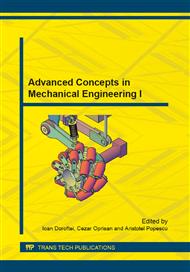p.55
p.59
p.65
p.71
p.77
p.83
p.89
p.95
p.99
Evaluation of Loss of Mass due to Corrosion Using Vibration-Based Methods
Abstract:
This paper present a procedure to detect wear or corrosion in structural elements based on frequency changes. Several methods to damage assessment are known, but these are mainly addressed to open cracks without considering the loss of mass. Since the mass decrease is a phenomenon associated with numerous corrosion mechanisms, the idea of this paper was to establish the influence of mass changes upon the natural frequencies of beam and to use it as a baseline in damage detection methods. Consequently, the research was conducted in two steps; first we analyzed the beam dynamics for a segment with reduced volumetric mass density but maintaining the global beam rigidity, succeeding to find the correlation between the frequency changes in the transversal vibration modes and mass loss in form of a mathematical relation. Afterwards, this relation was incorporated in the relation who predicts the frequency decreases due to stiffness diminish, in order to fit it for wear and corrosion assessment. The method’s robustness and reliability was proved by FEM simulations as well as by experiments.
Info:
Periodical:
Pages:
77-82
Citation:
Online since:
October 2014
Price:
Сopyright:
© 2014 Trans Tech Publications Ltd. All Rights Reserved
Share:
Citation:


